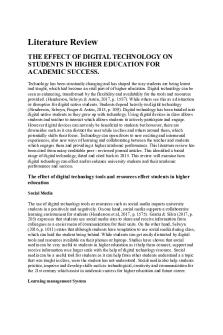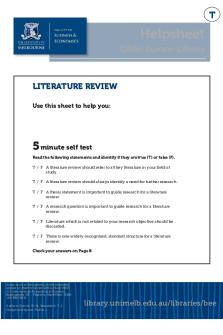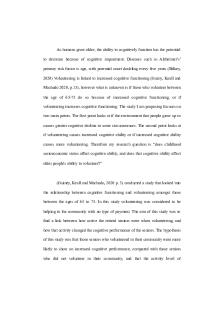Sample Literature Review PDF

| Title | Sample Literature Review |
|---|---|
| Author | Deema Alzamil |
| Course | Final Major Project |
| Institution | Kingston University |
| Pages | 6 |
| File Size | 319.3 KB |
| File Type | |
| Total Downloads | 49 |
| Total Views | 185 |
Summary
Download Sample Literature Review PDF
Description
Running head: LITERATURE REVIEW
1
A literature review is a survey of scholarly sources that provides an overview A literature review of a particular topic. It generally follows a discussion of the paper’s thesis statement or the study’s goals or purpose.
is a
Literature reviews are a collection of the most relevant and significant publications regarding that topic in order to provide a comprehensive look at what has been said on the topic and by whom.
Use of Propofol and Emergence Agitation in Children: A Literature Review Student Sample Title of Course Professor’s Name January 1, 2050 Be sure to format your title page according to your university’s guidelines.
*This sample paper was adapted by the Writing Center from Key, K.L., Rich, C., DeCristofaro, C., Collins, S. (2010). Use of Propofol and emergence agitation in children: A literature review . AANA Journal, 78(6). Retrieved from www.aana.com. Used with permission.
LITERATURE REVIEW
2
Use of Propofol and Emergence Agitation in Children: A Literature Review Emergence agitation (EA) during recovery from general anesthesia has been identified as a frequent problem in the pediatric population. In children, EA has been described as a mental disturbance that consists of confusion, hallucinations, and delusions manifested by moaning, restlessness, involuntary physical activity, and thrashing about in
The introduction starts by identifying the topic.
bed (Sikich & Lerman, 2004). The overall rate for EA in children is in the range of 10% to 67%, (Aouad & Nasr, 2005), which includes a period of severe restlessness, disorientation, and/or inconsolable crying during anesthesia emergence (Cole, Murray & McAllister, 2002). The age at which children are more likely to display signs of EA ranges from 2 to 5 years old and then begins to decline at age 62 months (Pryzbylo, Martini, Mazurek, Bracey, Johnsen & Cote, 2003). Additionally, the incidence of EA may be affected by individual variations in developmental level within an age group, mental disease, or neurologic conditions (Aouad & Nasr, 2005; Aouad, Yazbeck-Karam, Nasr, El Khatib, Kanazi, & Bleik, 2007; Bortone, Ingelmo, Grossi, 2006). These age groups are defined by the American Academy of Pediatrics (2008) in its Recommendations for Preventive Pediatric Health Care. Definitions are as follows: early childhood (15 months to 4 years old), middle childhood (5 to 10 years old), and early adolescence (11 to 12 years old). In this literature review, the most information was available on EA in the age groups of early and middle childhood, with additional studies that included early adolescents. Clinical Factors Related to Development of Emergence Agitation Populations studied for EA included the following characteristics: sex, ethnicity, type and active psychological status, and ASA class. Most studies f
The introduction wraps up with a clear thesis statement.
er in male and female populations. Some s tudies did separate age cohort higher Using level 1 headings, the literature review can be organized by study topic, building information about the topic through definitive academic contributions.
LITERATURE REVIEW
3
rate of EA has been seen in preschool boys anesthetized with sevoflurane compared with school-aged boys (Aouad & Nasr, 2005). The age of the child has been considered to be a factor in the development of EA postoperatively, perhaps because of the expected confusion and fright in this age group in response to perioperative events. Aono et al. (1999) concluded that preschool-aged boys showed a higher rate of emergence agitation than did school-aged boys when anesthetized with sevoflurane. Voepel-Lewis et al. (2003) noted that young age and anxiety level preoperatively were associated with EA. Many studies have confirmed that a younger age is a contributing factor in the development of EA, and most studies now target the ages of 2 through 6 years old when studying EA (Aouad & Nasr, 2005). When EA was first described by Eckenoff in 1961, it was speculated that patients were undergoing head and neck procedures may have a sense of suffocation during emergence from anesthesia, thus increasing the chance of EA. Surgical procedures that have been found to increase the risk of developing EA are otorhinolaryngology, ophthalmology, and neck procedures, all of which may produce a sense of suffocation (Aouad & Nasr, 2005; Vlajkovic & Sindjelic, 2007; VoepelLewis, Malviya, & Tait, 2003). The length of surgery in at least one study was found to be a factor associated with increased incidence of EA (Voepel-Lewis, Malviya, & Tait, 2003). In most studies, patients have been excluded if they were above ASA classes I and II, which is one limitation of the current literature (Baum, Yemen, & Baum, 1997). Exclusion criteria also included children with psychological or emotional disorders, developmental delay, and patients who needed sedative medication before inductio (Abu-Shahwan, 2008).
It is important to reference research on your topic in APA style.
LITERATURE REVIEW
4
Propofol TIVA techniques have also demonstrated a reduction in EA in children. In the study by Cohen et al. (2003) of sevoflurane inhalational anesthesia versus a Each subtopic has
propofol TIVA technique, there were of EA in the sevoflurane group subtopic has its own thesis own compared with the propofol group In the study by Picard et al. (2000) then “proven” through of the quality of recovery in children ane sthetic and propofol
statement that is then “proven” through the review of existing research.
research publications. TIVA techniques were compared, with a reduction in EA rates observed in the propofol TIVA group (46% versus 9%, respectively). A reduction in EA from 42% to 11% was seen in children 2 to 5 years of age with propofol TIVA compared with sevoflurane inhalational general anesthesia (Nakayama, Furukawa, & Yanai, 2007). The studies summarized in table A rates in sevoflurane alone, propofol TIVA alone compared with findings that demonstrate that in researching either using propofol adjunctively or using results in lower rates of EA compared with either sevoflurane alone or sevoflurane with adjunctive propofol. According to the literature evidence base, there is an advantage to either propofol TIVA or adjunctive propofol with sevoflurane (compared with sevoflurane alone). We conclude, based on the current evidence, that the use of propofol is associated with a reduction in the incidence of emergence agitation. Conclusion
A literature review articulates the purpose of your new project, which is to either fill a gap in current research or to provide the next step in researching the topic.
The reviewed literature suggests that there are advantages to the use of propofol TIVA techniques and adjunctive propofol anesthetics when combined with a sevoflurane inhalational technique. This reduction in EA with propofol use in conjunction with or separately from sevoflurane has been widely documented throughout the literature (Aouad et al., 2007; Abu-Shahwan, 2008). A major limitation of this literature is that numerous EA
LITERATURE REVIEW
5
assessment scales are used to compare various anesthetics. If future studies use the same validated assessment scale (such as the PAED), results can be more easily compared and strengthened. To better delineate the pathophysiology and causative factors regarding EA, more structured and multicenter studies with larger populations should be performed. Current research supports the use of propofol as discussed above; however, a continuation of current research with consistent and strengthened methodologies will help justify its use and application to clinical practice
The conclusion should be a succinct, oneparagraph reiteration of your literature review.
LITERATURE REVIEW References
A references list at the end of the paper will include entries for each publication discussed in the literature review.
Abu-Shahwan, I. (2008). Effect of Propofol on emergence behavior in children after sevoflurane general anesthesia. Paediatr Anaesth, 18(1), 55–59. Aono, J., Mamiya, K., & Manabe, M. (1999). Preoperative anxiety is associated with a high incidence of problematic behavior on emergence after halothane anesthesia in boys. Acta Anaesthesiol Scand, 43(5), 542–544. Aouad, M. T. & Nasr, V. G. (2005). Emergence agitation in children: an update. Curr Opin Anaesthesiol, 18(6), 614–619. Cohen, I. T., Finkel, J. C., Hannallah, R. S., Hummer, K. A., & Patel, K. M. (2003). Rapid emergence does not explain agitation following sevoflurane anaesthesia in infants and children: A comparison with propofol. Paediatr Anaesth., 13(1), 63–67. Eckenhoff, J. E., Kneale, D. H., & Dripps, R.D. (1961). The incidence and etiology of postanesthetic excitement: A clinical survey. Anesthesiology, 22, 667–673. Nakayama, S., Furukawa, H., & Yanai, H. (2007). Propofol reduces the incidence of emergence agitation in preschool-aged children as well as in school-aged children: A comparison with sevoflurane. J Anesth., 21(1), 19–23. Picard, V., Dumont, L., & Pellegrini, M. (2000). Quality of recovery in children: Sevoflurane versus propofol. Acta Anaesthesiol Scand., 44(3), 307–310. Uezono, S., Goto, T., Terui, K., et al. (2000). Emergence agitation after sevoflurane versus propofol in pediatric patients. Anesth Analg., 91(3), 563–566. Vlajkovic, G. P., & Sindjelic, R. P. (2007). Emergence delirium in children: Many questions, few answers. Anesth Analg., 104(1), 84–91....
Similar Free PDFs

Sample Literature Review
- 6 Pages

Literature Review
- 10 Pages

Literature Review
- 9 Pages

Literature Review
- 6 Pages

Literature Review
- 32 Pages

Literature Review
- 9 Pages

Literature Review
- 5 Pages

Literature Review
- 15 Pages

Literature Review
- 4 Pages

Literature Review
- 16 Pages

Systematic Literature Review
- 9 Pages

Mobile Learning Literature Review
- 26 Pages

Literature review on IFRS
- 11 Pages

Literature Review - guidelines
- 4 Pages

Chapter-2: LITERATURE REVIEW
- 48 Pages
Popular Institutions
- Tinajero National High School - Annex
- Politeknik Caltex Riau
- Yokohama City University
- SGT University
- University of Al-Qadisiyah
- Divine Word College of Vigan
- Techniek College Rotterdam
- Universidade de Santiago
- Universiti Teknologi MARA Cawangan Johor Kampus Pasir Gudang
- Poltekkes Kemenkes Yogyakarta
- Baguio City National High School
- Colegio san marcos
- preparatoria uno
- Centro de Bachillerato Tecnológico Industrial y de Servicios No. 107
- Dalian Maritime University
- Quang Trung Secondary School
- Colegio Tecnológico en Informática
- Corporación Regional de Educación Superior
- Grupo CEDVA
- Dar Al Uloom University
- Centro de Estudios Preuniversitarios de la Universidad Nacional de Ingeniería
- 上智大学
- Aakash International School, Nuna Majara
- San Felipe Neri Catholic School
- Kang Chiao International School - New Taipei City
- Misamis Occidental National High School
- Institución Educativa Escuela Normal Juan Ladrilleros
- Kolehiyo ng Pantukan
- Batanes State College
- Instituto Continental
- Sekolah Menengah Kejuruan Kesehatan Kaltara (Tarakan)
- Colegio de La Inmaculada Concepcion - Cebu
